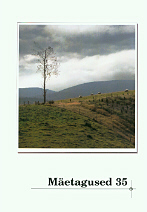Koolipärimuse kogumisest Noarootsis ja Vormsis 2006. aasta kevadel
On Collecting School Lore in Noarootsi and on Vormsi Island in Spring 2006
Author(s): Piret Voolaid Subject(s): Customs / Folklore
Published by: Eesti Kirjandusmuuseum
Keywords: Åland; Gotland; school lore; children’s lore; Noarootsi; Vormsi; fieldwork
Summary/Abstract: The article reviews the project of collecting school lore, instigated by Nordens Institut på Åland (the Nordic Institute on Åland) which aim was to collect school lore from Åland (Finland), Gotland (Sweden) and the former regions of coastal Swedes in Estonia in spring 2006. The collected material was published in a Swedish-language joke anthology Det var en ko och det var poängen (’Once there was a cow - and that’s it!’), in which the Estonian material is presented in two languages. In Estonia, the fieldwork for the project was carried out in April and May, 2006, in two general education schools in West Estonia: in Noarootsi School (with 138 pupils) and Vormsi Basic School (21 pupils). I undertook the three-day field trip to Noarootsi on my own, whereas on the two-day trip to the Vormsi Island I was accompanied by Alar Madisson, photographer of the Estonian Literary Museum, and Astrid Tuisk at the Estonian Folklore Archives. The choice of these two rural schools for folkloric fieldwork was made by our Swedish partners, who argued that these remain in the former settlement areas of the coastal Swedes and were particularly interested in the contemporary school lore of this particular region, which has been inhabited by Estonian Swedes for nearly eight centuries. The same fieldwork methods were applied in Noarootsi and Vormsi. First, the schoolchildren responded to questionnaires under the supervision of teachers. The questionnaires were based on one used in the 1992 major collection campaign for collecting school lore in Estonia. The children were asked to write down 1) jokes; 2) riddles, conundrums and trick tasks; 3) proverbs, truisms and set phrases/quip words; 4) horror tales and absurd tales; 5) parodies, songs, verses; 6) various predictions; 7) the repertoire of verse books, notebooks and friendship books; 8) various hobbies, customs and tricks; 9) games; 10) information on using the Internet. This was followed by in situ interviewing of children: 29 children from grades 4-6 (ages 10-12) were interviewed in Pürksi and children from four mixed year classes in Vormsi (ages 8-15, the total of 16 pupils). In addition to directed interviews, participation observation was used. The fieldwork expedition resulted in 90 pages of archive material, consisting of questionnaire responses from the Noarootsi School and 15 pages of responses from the Vormsi Basic School, constituting over 5 hours of audio-recordings, 1.5 hours of video-recorded material and 335 photographs.
Journal: Mäetagused. Hüperajakiri
- Issue Year: 2007
- Issue No: 35
- Page Range: 155-170
- Page Count: 16
- Language: Estonian

